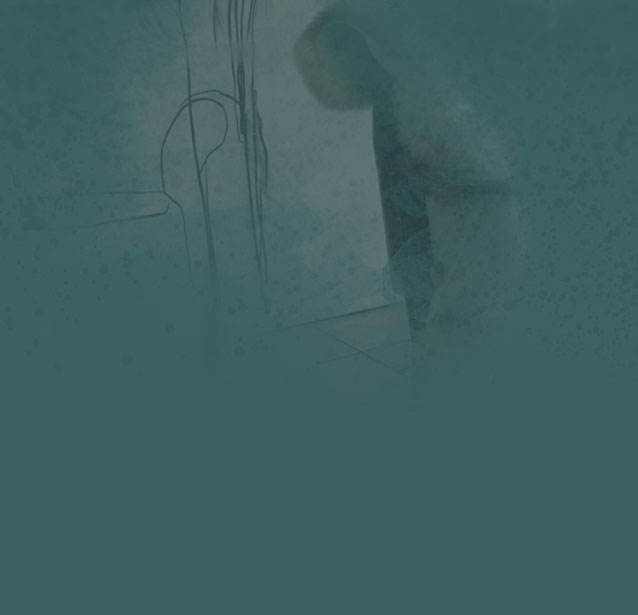Home
Konnerud Church, Drammen, 2001
Konnerud Church was consecrated in 1996, but two years passed before five artists were invited to compete for the decorative commission. Gullvåg once again won, and in 1998 he began work on the altarpiece.
In taking up this commission, Gullvåg needed to respond to an already-finished building. The apsidal wall is slightly concave, lit by a small window, together with side lighting from the long windows on either side. In order to respond to the wall’s curvature, Gullvåg’s altarpiece has a convex form, something that presses the altarpiece out towards the room and creates a beautiful spatial effect. The altarpiece’s upper curvature also harmonizes successfully with the tunnel vault.
Fourteen Stations
As is the case with the Seegård and Ellingsøy pictorial programs, the Passion of Christ is also central to this decorative schema. In Konnerud, the Way of the Cross – starting from where Jesus is sentenced to death, all the way to his place of execution – is gathered together in a pictorial frieze that frames the altarpiece. In the midst of this frame there rests a compelling version of the Supper at Emmaus.
If we consider the altarpiece as a whole, we note that the crosses establish a rhythm that draws us further into the narrative. The sunken middle field of the “clock” has a significant, meaningful function; it is the pictorial field where Jesus first falls, and it has slipped downwards to emphasize the weight of the cross and Jesus’ physical torment. As well as its relation to Christ, the Passion reminds us of all those throughout the world who bear crosses – those who are persecuted and those who suffer. For this, the most anguishing of Bible stories, interlocks with the barbarism of today; torture and injustice are unfortunately still burning issues.
Supper at Emmaus
In stark contrast to the dismal Passion frieze, the main motif of the Konnerud Altarpiece radiates towards us in warm colour-harmonies. While the progress of the Way of the Cross was disturbed and fragmented, now peace and harmony rest upon the table. The meal scene is cunningly contrived. Its composition has three main parts, and painted shadow-effects suggest that all three figures are situated in niches curving into the room; thus they repeat the apse’s form. The many right angles of the Passion frieze subtly establish a cross with Christ in the centre.
Konnerud Church was consecrated in 1996, but two years passed before five artists were invited to compete for the decorative commission. Gullvåg once again won, and in 1998 he began work on the altarpiece.
In taking up this commission, Gullvåg needed to respond to an already-finished building. The apsidal wall is slightly concave, lit by a small window, together with side lighting from the long windows on either side. In order to respond to the wall’s curvature, Gullvåg’s altarpiece has a convex form, something that presses the altarpiece out towards the room and creates a beautiful spatial effect. The altarpiece’s upper curvature also harmonizes successfully with the tunnel vault.
Fourteen Stations
As is the case with the Seegård and Ellingsøy pictorial programs, the Passion of Christ is also central to this decorative schema. In Konnerud, the Way of the Cross – starting from where Jesus is sentenced to death, all the way to his place of execution – is gathered together in a pictorial frieze that frames the altarpiece. In the midst of this frame there rests a compelling version of the Supper at Emmaus.
If we consider the altarpiece as a whole, we note that the crosses establish a rhythm that draws us further into the narrative. The sunken middle field of the “clock” has a significant, meaningful function; it is the pictorial field where Jesus first falls, and it has slipped downwards to emphasize the weight of the cross and Jesus’ physical torment. As well as its relation to Christ, the Passion reminds us of all those throughout the world who bear crosses – those who are persecuted and those who suffer. For this, the most anguishing of Bible stories, interlocks with the barbarism of today; torture and injustice are unfortunately still burning issues.
Supper at Emmaus
In stark contrast to the dismal Passion frieze, the main motif of the Konnerud Altarpiece radiates towards us in warm colour-harmonies. While the progress of the Way of the Cross was disturbed and fragmented, now peace and harmony rest upon the table. The meal scene is cunningly contrived. Its composition has three main parts, and painted shadow-effects suggest that all three figures are situated in niches curving into the room; thus they repeat the apse’s form. The many right angles of the Passion frieze subtly establish a cross with Christ in the centre.
HÅKON GULLVÅG © / TEXTS BY DANIEL JOHANSEN AND EVA FURSETH / SITE BY KLIPP OG LIM































































